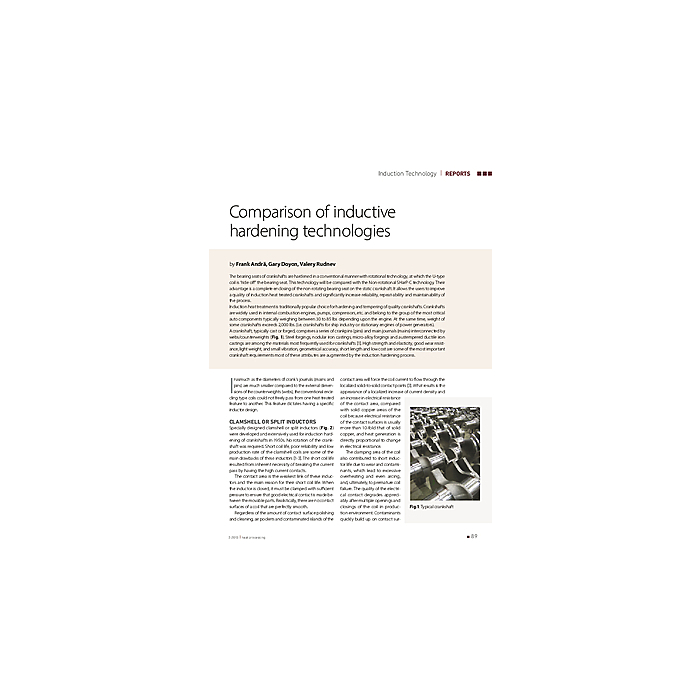Comparison of inductive hardening technologies
4,90 €
Auf Lager
Artikelnummer
00541_2013_02_06
The bearing seats of crankshafts are hardened in a conventional manner with rotational technology, at which the U-type coil is “ride off” the bearing seat. This technology will be compared with the Non-rotational SHarP-C technology. Their advantage is a complete enclosing of the non-rotating bearing seat on the static crankshaft. It allows the users to improve a quality of induction heat treated crankshafts and significantly increase reliability, repeat-ability and maintainability of the process. Induction heat treatment is traditionally popular choice for hardening and tempering of quality crankshafts. Crankshafts are widely used in internal combustion engines, pumps, compressors, etc. and belong to the group of the most critical auto components typically weighing between 30 to 85 lbs depending upon the engine. At the same time, weight of some crankshafts exceeds 2,000 lbs. (i.e. crankshafts for ship industry or stationary engines of power generators). A crankshaft, typically cast or forged, comprises a series of crankpins (pins) and main journals (mains) interconnected by webs/counterweights (Fig. 1). Steel forgings, nodular iron castings, micro-alloy forgings and austempered ductile iron castings are among the materials most frequently used for crankshafts [1]. High strength and elasticity, good wear resist-ance, light weight, and small vibration, geometrical accuracy, short length and low cost are some of the most important crankshaft requirements most of these attributes are augmented by the induction hardening process.
| Autoren | Frank Andrä/Gary Doyon, Valery Rudnev |
|---|---|
| Erscheinungsdatum | 01.02.2013 |
| Format | |
| Zeitschrift | heat processing - Issue 02 2013 |
| Verlag | Vulkan-Verlag GmbH |
| Sprache | English |
| Seitenzahl | 7 |
| Titel | Comparison of inductive hardening technologies |
| Beschreibung | The bearing seats of crankshafts are hardened in a conventional manner with rotational technology, at which the U-type coil is “ride off” the bearing seat. This technology will be compared with the Non-rotational SHarP-C technology. Their advantage is a complete enclosing of the non-rotating bearing seat on the static crankshaft. It allows the users to improve a quality of induction heat treated crankshafts and significantly increase reliability, repeat-ability and maintainability of the process. Induction heat treatment is traditionally popular choice for hardening and tempering of quality crankshafts. Crankshafts are widely used in internal combustion engines, pumps, compressors, etc. and belong to the group of the most critical auto components typically weighing between 30 to 85 lbs depending upon the engine. At the same time, weight of some crankshafts exceeds 2,000 lbs. (i.e. crankshafts for ship industry or stationary engines of power generators). A crankshaft, typically cast or forged, comprises a series of crankpins (pins) and main journals (mains) interconnected by webs/counterweights (Fig. 1). Steel forgings, nodular iron castings, micro-alloy forgings and austempered ductile iron castings are among the materials most frequently used for crankshafts [1]. High strength and elasticity, good wear resist-ance, light weight, and small vibration, geometrical accuracy, short length and low cost are some of the most important crankshaft requirements most of these attributes are augmented by the induction hardening process. |
Eigene Bewertung schreiben


